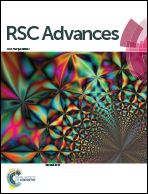Development of hydrolysed protein-based plywood adhesive from slaughterhouse waste: effect of chemical modification of hydrolysed protein on moisture resistance of formulated adhesives†
Abstract
Specified risk materials (SRM) constitute the proteinaceous waste of slaughterhouses and are currently being disposed off either by incineration or by land filling. Over the last few years, our efforts have focused on developing technology platforms for deployment of this renewable resource for various value-added industrial applications. This report describes a technology for utilization of SRM for the development of an environmentally friendly plywood adhesive with an improved water resistance property. The feedstock (SRM) was first thermally hydrolysed according to a standard protocol, and the hydrolysed protein fragments (peptides) were recovered from the hydrolysate. The recovered peptides were chemically modified through esterification reaction using ethanol, and then chemically crosslinked with polyamideamine-epichlorohydrin (PAE) resin to develop a wood adhesive system. Plywood specimens were then developed using the peptides–PAE resin-based adhesive. The effects of crosslinking time, solid content of the adhesive formulation, ratio of peptides and crosslinking agent in the formulation, and curing conditions of specimen preparation on lap shear strength of resulting plywood specimens were systematically evaluated. Despite the hydrophilic nature of hydrolysed protein fragments, the peptides–PAE resin formulations exhibited remarkable water resistance property after curing. Capping of polar carboxyl groups of peptides by converting them to esters further improved the water resistance property of this adhesive system. Under the optimum conditions of adhesive preparation and curing, the ethyl ester derivative of peptides and PAE resin-based formulations resulted in plywood specimens having comparable dry as well as soaked shear strengths to those of commercial phenol formaldehyde resin.



 Please wait while we load your content...
Please wait while we load your content...